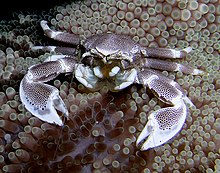Porcelain crab
| Porcelain crabs Temporal range:
| |
|---|---|

| |
| Southeastern Pacific species of Petrolisthes, Allopetrolisthes and Liopetrolisthes | |
| Scientific classification | |
| Domain: | Eukaryota |
| Kingdom: | Animalia |
| Phylum: | Arthropoda |
| Class: | Malacostraca |
| Order: | Decapoda |
| Suborder: | Pleocyemata |
| Infraorder: | Anomura |
| Superfamily: | Galatheoidea |
| Family: | Porcellanidae Haworth, 1825 |
| Genera | |
|
See text | |
Porcelain crabs are decapod crustaceans in the widespread family Porcellanidae, which superficially resemble true crabs. They have flattened bodies as an adaptation for living in rock crevices. They are delicate, readily losing limbs when attacked, and use their large claws for maintaining territories. They first appeared in the Tithonian age of the Late Jurassic epoch, 145–152 million years ago.
Description
Porcelain crabs are small, usually with body widths less than 15 millimetres (9⁄16 inch).
Evolution
Porcelain crabs are an example of
Biogeography and ecology


Porcelain crabs live in all the world's oceans, except the Arctic Ocean and the Antarctic.[7] They are common under rocks, and can often be found and observed on rocky beaches and shorelines, startled creatures scurrying away when a stone is lifted. They feed by combing plankton and other organic particles from the water using long setae (feathery hair- or bristle-like structures) on the mouthparts.[4]
Some of the common species of porcelain crabs in the Caribbean Sea are Petrolisthes quadratus, found in large numbers under rocks in the intertidal, and the red-and-white polka-dotted Porcellana sayana, which lives commensally within the shells inhabited by large hermit crabs. In Hong Kong, Petrolisthes japonicus is common.[2]
Diversity
As of 2018[update], some 4723 extant species of porcelain crab had been described,[8][citation needed] divided among these 30 genera:[8][9]
- Aliaporcellana Nakasone & Miyake, 1969
- Allopetrolisthes Haig, 1960
- Ancylocheles Haig, 1978
- Capilliporcellana Haig, 1978
- Clastotoechus Haig, 1960
- Enosteoides Johnson, 1970
- Euceramus Stimpson, 1860
- Eulenaios Ng & Nakasone, 1993
- Heteropolyonyx Osawa, 2001
- Heteroporcellana Haig, 1978
- Liopetrolisthes Haig, 1960
- Lissoporcellana Haig, 1978
- Madarateuchus Harvey, 1999
- Megalobrachium Stimpson, 1858
- Minyocerus Stimpson, 1858
- Neopetrolisthes Miyake, 1937
- Neopisosoma Haig, 1960
- Novorostrum Osawa, 1998
- Orthochela Glassell, 1936
- Pachycheles Stimpson, 1858
- Parapetrolisthes Haig, 1962
- Petrocheles Miers, 1876
- Petrolisthes Stimpson, 1858
- Pisidia Leach, 1820
- Polyonyx Stimpson, 1858
- Porcellana Lamarck, 1801
- Porcellanella White, 1852
- Pseudoporcellanella Sankarankutty, 1962
- Raphidopus Stimpson, 1858
- Ulloaia Glassell, 1938
The
- Annieporcellana Fraaije et al., 2008
- Beripetrolisthes De Angeli & Garassino, 2002
- Eopetrolisthes De Angeli & Garassino, 2002
- Lobipetrolisthes De Angeli & Garassino, 2002
- Longoporcellana Müller & Collins, 1991
The earliest claimed porcelain crab fossil was Jurellana from the Tithonian aged Ernstbrunn Limestone of Austria.[10] However, it was subsequently determined to be a true crab. With the new oldest porcelain crab being Vibrissalana from the same locality.[11]
References
- ^ ISBN 978-0-520-25118-2.
- ^ ISBN 978-962-209-027-9.
- ^ ISBN 978-0-643-06906-0.
- ^ ISBN 978-962-593-157-9.
- PMID 11886621.
- S2CID 26260996.
- ^ P. McLaughlin, S. Ahyong & J. K. Lowry (October 2, 2002). "Porcellanidae Haworth, 1825". Anomura: Families. Australian Museum. Archived from the original on April 29, 2005. Retrieved February 10, 2005.
- ^ a b Masayuki Osawa & Patsy A. McLaughlin (2010). "Annotated checklist of anomuran decapod crustaceans of the world (exclusive of the Kiwaoidea and families Chirostylidae and Galatheidae of the Galatheoidea) Part II – Porcellanidae" (PDF). Zootaxa. Suppl. 23: 109–129. Archived from the original (PDF) on 2012-03-02.
- ^ WoRMS (2010). "Porcellanidae". World Register of Marine Species. Retrieved November 13, 2010.
- ^ .
- ISSN 0024-4082.
